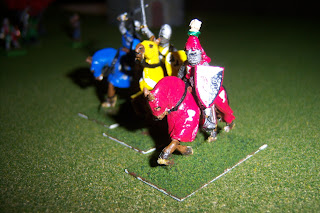http://www.hisentco.com/Private/Pages/Downloads.html
The teams:

Here we see John Comyn and retinue prepparing for less than lethal combat. Usually combatants used light padded armor and blunted weapons for tournaments.
Of course the possibility of being gravely or mortally wounded is still in play

English Knights present to the tournament. The tournament circuit was a money maker for Knights during periods of peace. In mock combat knights could win a collective purse, take other knights and hold them ransom. Often the ransom was either a horse and set of armor or a sum of money equal to it.
The atmosphere: squires and locals would erect pavilions, the field was left open ended so that the mock combat could include the "thrill of the chase" when enemies broke and ran. Local vendors would be on hand to sell beer, cider and bread. Sporting games of darts, bowling, archery and feats of strength would warm up the spectators while knights prepared. Strange fashions often accompanied the women who attended tournaments - attire that was overly showy and distracting was typical. Dresses that left the breasts bare, overly colorful fashions and promiscuous attire were among the displays that made tournaments banned events and quite popular. When a favorite knight would be injured or killed the tournament could break out into a full riot with horsemen riding down peasants and local magistrates arresting dozens.
See A Distant Mirror and Life in a Medieval Castle for references.

The Scottish Lord and his Knights ride onto the field.
While during the period before the 1st Scottish War of Independence it was more typical to see larger mock combats between groups of chevaliers, it was not unheard of to see jousts between single armed opponents - it was simply more common on the continent. In fact Edward the 1st suffered a wound at the age of 17 from such a tournament.
more to follow soon, coming up: the turn by turn analysis and outcome of the tournament.

No comments:
Post a Comment